Notes: Warrington Arpley station was a joint facility of the Warrington & Stockport Railway (W&S) and the St Helens Canal & Railway Company (SHC&RC) located on the south side Warrington at the point where the two companies’ lines made an end-on connection.
The W&S line was authorised on 3 July 1851 as a line of the Warrington and Altrincham Railway (W&A) that would run from a connection with the Manchester South Junction & Altrincham Railway (MSJAR) at Timperley Junction to Warrington. At Warrington the W&A was authorised to make an end-on connection with the SHC&RC Garston and Warrington line and connect with the London & North Western Railway (LNWR) and the Birkenhead Joint Railway (BJR) at Walton Junction. On 4 August 1853 the W&A changed its name to the W&S, and it opened from Broadheath to a temporary station at Warrington Wilderspool, on the east side of the River Mersey, on 1 November 1853.
A bridge over the Mersey was completed in the early months of 1854 and the W&S opened to Warrington Arpley station, where they had their headquarters, on 1 May 1854. On the same day the line was also extended to Timperley Junction where it connected to the MSJAR.
The SHC&RC Garston and Warrington line had reached a temporary station at Warrington White Cross on 1 February 1853 and it was extended through to Warrington Arpley for the opening of that station on 1 May 1854.
Warrington Arpley was located on the southern edge of Warrington town centre. It was reached by an approach road that connected to Wilson Patten Street and to Bridge Street. The main facilities were on the north side of the line and fronted onto the approach road. They were provided in a dignified brick structure of ample proportions under a hipped roof, looking not unlike a stately home. So generous was its size that the local newspaper commented that one end of the building ‘might well be let off to the Corporation as baths, baths as large as St Georges Pier Head, Liverpool’; in fairness, as noted above, the building was intended to accommodate the headquarters of the company as well as the needs of passengers.
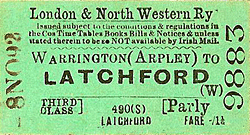 The centrepiece of the two-storey, E-plan building was a large pediment with three windows beneath; on the ground floor the rectangular openings had dripstones above, and on the upper floor a Venetian window was flanked by rectangular openings, each with a pediment. The absence of the doorway and portico that might be expected in the centrepiece detracted somewhat from the visual satisfaction of the building. In the wings at either end of the building the single upper storey window was surmounted by a pediment, with a triple-arched window on the ground floor. Between the centrepiece and each of the two wings was a range of windows, with pediments on the upper floor and dripstones on the ground floor. String courses added interest between the ground and upper floors. The chimneystacks were of modest size. Originally a sloping glazed awning was clasped between the centrepiece and each of the wings. Less ornamentation was provided on the straight platform elevation where a range of twelve windows with dripstones overlooked the trainshed, or later, the canopy. On the south platform there appear to have been no facilities; a screen wall supported the trainshed. The centrepiece of the two-storey, E-plan building was a large pediment with three windows beneath; on the ground floor the rectangular openings had dripstones above, and on the upper floor a Venetian window was flanked by rectangular openings, each with a pediment. The absence of the doorway and portico that might be expected in the centrepiece detracted somewhat from the visual satisfaction of the building. In the wings at either end of the building the single upper storey window was surmounted by a pediment, with a triple-arched window on the ground floor. Between the centrepiece and each of the two wings was a range of windows, with pediments on the upper floor and dripstones on the ground floor. String courses added interest between the ground and upper floors. The chimneystacks were of modest size. Originally a sloping glazed awning was clasped between the centrepiece and each of the wings. Less ornamentation was provided on the straight platform elevation where a range of twelve windows with dripstones overlooked the trainshed, or later, the canopy. On the south platform there appear to have been no facilities; a screen wall supported the trainshed.
At the rear of the station building were two platforms separated by four tracks. The eastbound platform (which became the up direction) was directly behind the building and was reached by passing through it. Passengers gained access to the westbound (later, down) platform by crossing the tracks at the east end of the station where a barrow crossing was provided. Over the platforms there was a trainshed roof of timber and glass.
To the south of the station there was a covered shed for goods wagons and, to the south of this building, a two road engine shed. Further goods facilities were west of the station on the north side of the line; they included a goods shed and a number of sidings.
At the time of opening Warrington Arpley was served by trains to and from Garston and St Helens on the SHC&RC system and to and from Broadheath on the W&S. Broadheath was an inconvenient location and had not been the intended eastern terminus of the line. The purpose of the W&S had been to create a route from Warrington to Manchester via the MSJAR railway. In doing so the SHC&RC would be able to reach Manchester from Garston and the BJR would have a link to the city from its network. The problem was that the MSJAR was under the joint ownership of the London North Western Railway (LNWR) & the Manchester, Sheffield & Lincolnshire Railway (MS&LR). The LNWR was hostile to the idea of trains running between the BJR and the SHC&RC lines and Manchester as they saw this as creating alternative routes that would compete with its own. For that reason the LNWR obstructed the W&S putting it in a precarious financial position.
Legal wrangling followed, and an arbitrator gave the W&S the right to run its trains over the MSJAR line to Manchester Oxford Road but at a financial cost that the W&S considered to be too high. The W&S had no choice but to pay, and their trains started to run between Warrington Arpley and Manchester Oxford Road on 31 October 1854.
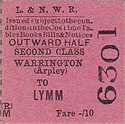 Things went from bad to worse for the W&S. Companies such as the BJR had obtained running rights over the line and the W&S had anticipated healthy receipts from them. The Great Western Railway (GWR) was a partner in the BJR and it intended to run services to Manchester via the W&S. In spring 1855 the line from Warrington Arpley to Walton Junction opened (the junction being just to the west of the station) making the GWR plan feasible. The problem was that the GWR and the LNWR were hostile to each other and the LNWR would not allow the GWR to use the MSJAR. The W&S had obtained an Act to build a line to Stockport at the time of its name change, but because of the turn of events it did not have the funds to proceed and the powers lapsed. The W&S company was never to reach Stockport. Things went from bad to worse for the W&S. Companies such as the BJR had obtained running rights over the line and the W&S had anticipated healthy receipts from them. The Great Western Railway (GWR) was a partner in the BJR and it intended to run services to Manchester via the W&S. In spring 1855 the line from Warrington Arpley to Walton Junction opened (the junction being just to the west of the station) making the GWR plan feasible. The problem was that the GWR and the LNWR were hostile to each other and the LNWR would not allow the GWR to use the MSJAR. The W&S had obtained an Act to build a line to Stockport at the time of its name change, but because of the turn of events it did not have the funds to proceed and the powers lapsed. The W&S company was never to reach Stockport.
In 1856 agreement was reached with the LNWR to extend some of the MSJAR trains to Warrington Arpley and effectively use the W&S as an extension of that line. The arrangement made for a better passenger service and one that delivered an operating surplus. Operation of the service began on 1 October 1856.
The SHC&RC services from Warrington Arpley were more stable and much more profitable. Typically there were six departures and arrivals each day. Three of the trains ran to and from St Helens - with a reversal at Runcorn Gap [Widnes] - and three ran to and from Garston.
In 1857 the working relationship between the MS&LR and LNWR fractured and the companies became enemies. A railway war ensued and the MS&LR began to negotiate with the GWR. The MS&LR was now more than happy to allow the GWR to reach Manchester via the MSJAR line, which would have put the W&S on a more sound financial footing. The LNWR was quick to act, however, and it opened up negotiations with the GWR, agreeing in November 1858 to allow them to reach Manchester via LNWR lines.
The MS&LR began operating passenger services between Manchester and Garston, where an onward connection to Liverpool could be made by omnibus. They also introduced a service between Manchester and Chester via Warrington Arpley. This was in direct competition with the LNWR and gave Arpley perhaps the most diverse service it ever had.
In April 1858 a Crimean War memorial was unveiled opposite the main entrance to Warrington Arpley station. The memorial included Russian guns that had been taken at the siege of Sebastopol on 8 September 1855. They were presented to the Mayor of Warrington by the Government in recognition of the sufferings of the British soldiers who took part in the war. The guns were mounted either side of an ornate plinth surmounted by a street lamp. The memorial was placed on a dias which was enclosed by railings. Dedicatory stone tablets were located on the side of the plinth.
From June 1858 the Great Northern Railway (GNR), at that time allied to the MS&LR, introduced a passenger service between London Kings Cross and Garston that served Warrington Arpley giving it a direct connection to the capital.
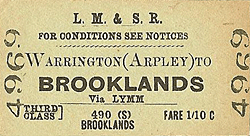 For a brief period during the railway war the W&S line had taken on a role of importance just as its promotors had anticipated. During 1858 the SHC&RC and the MS&LR considered leasing the W&S but in autumn1858 the railway war ended. It had cost all of the companies a great deal of money as they had cut fares and put on services in competition to each other. The ending of the railway war saw the withdrawal of the GNR London Kings Cross service. In November 1858 Warrington Arpley lost the MS&LR services between Manchester and Garston/Chester. For a brief period during the railway war the W&S line had taken on a role of importance just as its promotors had anticipated. During 1858 the SHC&RC and the MS&LR considered leasing the W&S but in autumn1858 the railway war ended. It had cost all of the companies a great deal of money as they had cut fares and put on services in competition to each other. The ending of the railway war saw the withdrawal of the GNR London Kings Cross service. In November 1858 Warrington Arpley lost the MS&LR services between Manchester and Garston/Chester.
To counter any future threats the LNWR took out a lease of the W&S on 13 August 1859 and absorbed it fully on 1 January 1861. A lease was taken out by the LNWR on the SHC&RC Warrington & Garston line on 1 September 1860 which effectively made Warrington Arpley station an LNWR station.
On 15 February 1864 a line was opened from Speke Junction (to the east of Garston) to Edge Hill (Liverpool) which allowed the LNWR to run trains from Warrington Arpley to Liverpool. On 1 September 1864 the LNWR absorbed the SHC&RC. The LNWR operated mostly local trains from Warrington Arpley but it did use the line between Garston and Timperley Junction extensively for goods services.
On 1 December 1865 the former W&S was finally connected to Stockport when the Cheshire Lines Committee (CLC) opened a line from Broadheath (Deansgate Junction) to Stockport Tiviot Dale. The CLC was a joint railway of the MS&LR, the GNR and the Midland Railway (MR). The CLC had obtained running rights over the line between Garston and Broadheath, and they had taken over the Garston & Liverpool Railway (opened 1 May 1864) giving them a route between Stockport and Liverpool. One of the CLC partners was the MS&LR, so a route was also available between Manchester and Liverpool via Warrington Arpley and the CLC introduced passenger services onto the lines; consequently Warrington Arpley was served by trains of the LNWR and the CLC partners. Passengers could travel either to Liverpool Lime Street by LNWR or Liverpool Brunswick by CLC. Journeys could be made to Manchester Oxford Road by LNWR or CLC. They could also reach Stockport by CLC. Trains to more distant locations were operated by the GNR, the MS&LR and the MR.
Less than a half a mile to the west of Arpley the LNWR’s main line, which provided a link between London and Scotland, passed over the Garston line. The Warrington station on that line was located to the north of the former SHC&RC route. As soon as the LNWR had taken over the Garston line it developed plans to build a new station at the point where the lines crossed so that there could be convenient interchange opportunities. Economy was also a factor as the LNWR considered that it could close Arpley and have just one station in Warrington. The new station opened on 16 November 1868 and Warrington Arpley was closed. However the townspeople of Warrington objected strongly to the closure of Arpley station as it was much more closer to the town centre than Bank Quay. A campaign was launched, supported by the town Council and the local press, to force the LNWR to reopen Arpley. One newspaper reported that the low level platforms at Bank Quay were ‘nothing more than a covered shed’. The campaign succeeded and Warrington Arpley reopened on 2 October 1871.
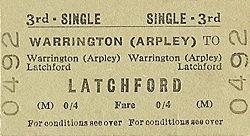 Once again the rivalry between companies had an impact on Warrington Arpley. The LNWR did all that it could to inconvenience the CLC trains. This resulted in the CLC building its own line between Garston and Manchester, with a branch to Stockport. The line opened in two stages on 1 August and 2 September 1873 and Warrington Arpley lost its CLC services. Once again the rivalry between companies had an impact on Warrington Arpley. The LNWR did all that it could to inconvenience the CLC trains. This resulted in the CLC building its own line between Garston and Manchester, with a branch to Stockport. The line opened in two stages on 1 August and 2 September 1873 and Warrington Arpley lost its CLC services.
By the 1890s the goods facilities at Arpley had been enlarged and included a coal yard to the north of the station forecourt. The lines that led into the yard crossed the access road at its western end. A footbridge had also been provided to link the up and down platforms. The footbridge was located at the eastern end of the station.
The December 1895 timetable showed Warrington Arpley as having 14 up and 17 down trains on Monday-to-Friday. There were 15 up trains on Saturdays and three trains in each direction on Sundays. Destinations served included Liverpool Lime Street, Lymm, Manchester London Road, Stockport Edgeley and Warrington Bank Quay.
Shortly after 1905 the trainshed roof was demolished to be replaced with canopies on each platform; these had a hipped profile glazed section with a flat extension towards the platform edge, and were provided with serrated valances.
The July 1922 timetable showed Warrington Arpley as having 15 up and 14 down trains Monday-to-Saturday and only two trains in each direction on Sundays.
On 1 January 1923 Warrington Arpley became part of the London Midland & Scottish Railway (LMS). The pattern of train services remained broadly similar to that provided by the LNWR. The summer 1932 timetable showed 14 up and 16 down trains on Monday-to-Friday. On Saturdays during the summer period Warrington Arpley was served by a number of trains to Llandudno from destinations such as Leeds and Bury. On Sundays there were just two trains in each direction.
By the 1930s the station forecourt was being used as a bus terminus for local and inter-urban services. Although the locating of a bus terminus adjacent to the railway station sounds like an early model of intermodal transport planning the reality was that there was a duplication of routes and the LMS would have lost passenger business.
The outbreak of the Second World War on 3 September 1939 led to a reduction in passenger services from Warrington Arpley. In 1940 the Russian guns were removed for the war effort and the inscribed tablets of the Crimean war memorial were removed and later erected in Warrington’s Victoria Park.
After the war passenger services did not return to their pre-war levels. The LMS 1947 summer timetable showed only ten up and nine down services Monday-to-Friday. On Saturdays there was an extra train in each direction and a service from Manchester that terminated at Arpley. No trains served Warrington Arpley on Sundays. There was a much better service in the eastbound direction as only four trains went any further west than Warrington Bank Quay.
Up Trains Summer 1947 |
Destination |
Down Trains Summer 1947 |
Destination |
6.29am |
Manchester London Road |
7.40am |
Liverpool Lime Street |
6.57am |
Manchester London Road |
8.20am |
Warrington Bank Quay |
7.55am |
Manchester London Road |
8.37am |
Ditton Junction |
8.37am |
Manchester London Road |
12.40pm (Saturday Only) |
Warrington Bank Quay |
10.12am (Saturday Only) |
Timperley |
1.11pm |
Ditton Junction |
1.10pm |
Manchester London Road |
4.55pm |
Liverpool Lime Street |
4.17pm |
Manchester London Road |
5.46pm |
Warrington Bank Quay |
5.37pm |
Manchester London Road |
6.17pm |
Warrington Bank Quay |
7.27pm |
Manchester London Road |
7.58pm |
Warrington Bank Quay |
8.53pm |
Manchester London Road |
9.57pm |
Warrington Bank Quay |
10.09pm |
Manchester London Road |
11.37pm (Saturday Only) |
Terminating service from Manchester |
On 1 January 1948 Warrington Arpley became part of British Railways (London Midland Region). In the second year after nationalisation there was a similar level of service to that which had been offered by the LMS in 1947 but there were no Sunday trains. By the mid 1950s the service had reduced further. The September 1956 – June 1957 timetable showed only eight up and six down trains from Arpley Monday-to-Friday. There were an extra two down trains on Saturdays. Only four of the down trains went any further west than Warrington Bank Quay Monday-to-Friday and only three did on Saturdays. There were no Sunday trains.
The proximity of Warrington Arpley and Warrington Bank Quay stations had been a contentious issue for the railway authorities since he LNWR had been forced to reopen Arpley in 1871. The situation in the 1950s, however, was very different as road transport in the form of buses was available to passengers and was often much more convenient for local journeys. One of the bus services that operated from the Arpley bus station was the Crosville H1. It ran between Warrington and Liverpool and passed close to most of the stations of the route between Arpley and Liverpool Lime Street. Furthermore it served areas of population and town centres at places such as Widnes which the railway did not. It also ran more frequently than the train and at regular intervals. So, although slower than the train, the H1 was a much better option for most people. British Railways successfully sought approval to close Warrington Arpley, It closed on 15 November 1958, the last trains having run on Saturday 13 November 1958.
Regular passenger services continued to pass through Warrington Arpley until 8 September 1962 when they were withdrawn between Ditton Junction and Broadheath and all of the remaining stations (except for the Warrington Bank Quay low level platforms) were closed to passengers. After that date there was only a Liverpool to York night service and summer Saturday Sheffield and North Wales services that passed through the station. These services had ceased by the end of 1965 leaving only the occasional passenger diversion.
The down platform at Arpley was demolished in the early 1960s and the station building in 1968. The station forecourt remained in use as a bus station until the early 1980s after which it was developed with industrial units. The locomotive shed at Arpley closed on 27 May 1963. Ever since LNWR days the line had been more important for freight than for passengers. It continued to be a busy freight route especially for coal conveyed from Yorkshire to Garston and, from the late 1960s, to Fiddlers Ferry power station. A locomotive stabling point was developed adjacent to the station site in the 1970s; it lasted until the early 1990s after which it was moved a short distance to the west.
On 7 July 1985 the former W&S railway between Latchford and Skelton Junction closed because a bridge over the Manchester Ship Canal (opened in 1893) needed significant repairs. The line had 60 booked trains per day but British Rail considered that they could be diverted along other routes. However an effect of the closure was that trains from the main line had to run to Latchford and then reverse to continue west; the same was true for trains from the west en route to the main line; this applied to the Fiddlers Ferry traffic. Because of the need for these activities the Warrington Arpley station site remained a very busy place into the 21st century.
In 2004 the tablets from the Crimean War Memorial were moved from Victoria Park to Palmyra Square and erected, once again, in a place of prominence. Click here to see photos.
Tickets by Michael Stewart and route map by Alan Young.
Sources:
- Encyclopaedia of British Railway Companies - Christopher Awdry - Guild Publishing 1990
- The Manchester South Junction & Altrincham Railway - Martain Bairstow - Published by Martin Bairstow 2014.
- The Manchester South Junction & Altrincham Railway - Frank Dixon - The Oakwood Press 1994
- The St Helens Railway, Its Rivals and Successors – J M Tolston – The Oakwood Press 1982.
- Bradshaw Timetable December 1895.
- Bradshaw Timetable July 1922.
- LMS Timetable Summer 1932.
- BR (LMR) Timetable May - Sept 1948.
- BR (LMR) Timetable September 1956.
To see the other
stations on the Garston and Warrington railway click
on the station name: Garston Dock, Speke, Halebank, Ditton, Ditton Mill, Widnes (1st), Widnes South, Cuerdley, Fidlers
Ferry & Penketh, Sankey
Bridges &
Warrington
Bank Quay Low Level.
To see stations on the Warrington and Stockport railway click on the station name: Latchford (2nd), Thelwall, Lymm, Heatley &
Warburton,
Dunham Massey & Broadheath. |

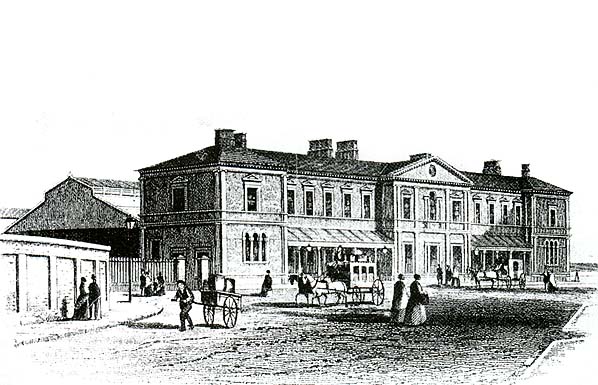
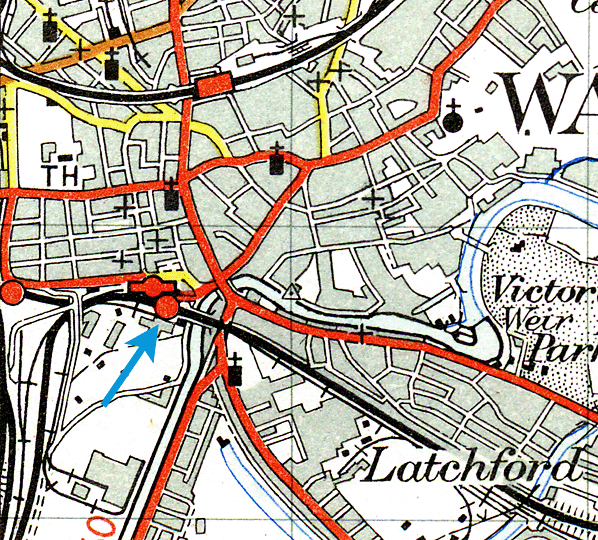
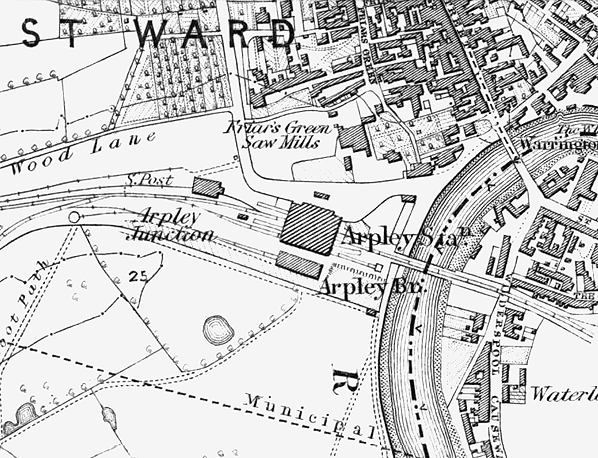
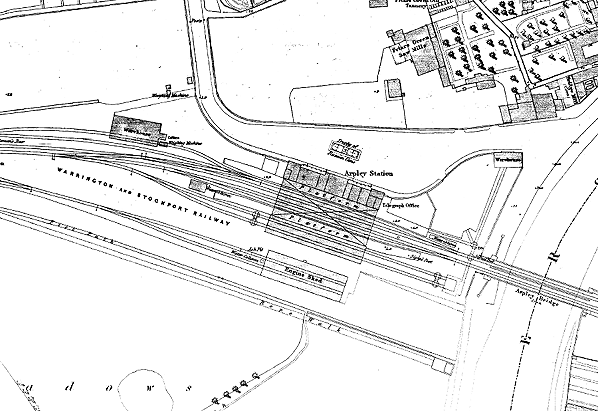
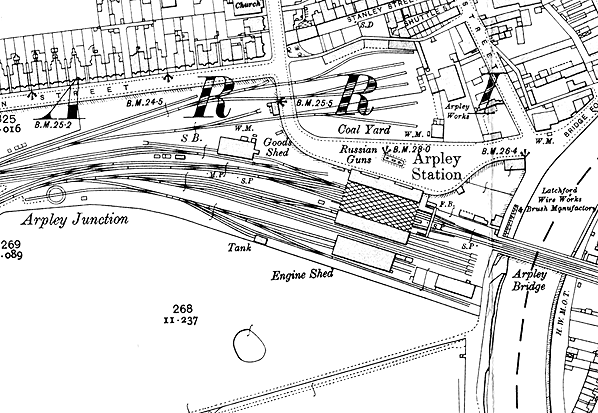
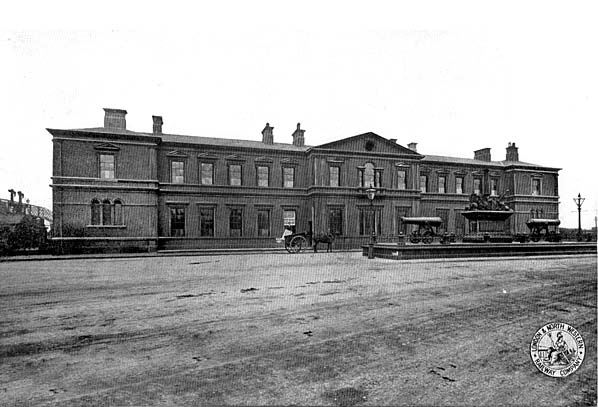
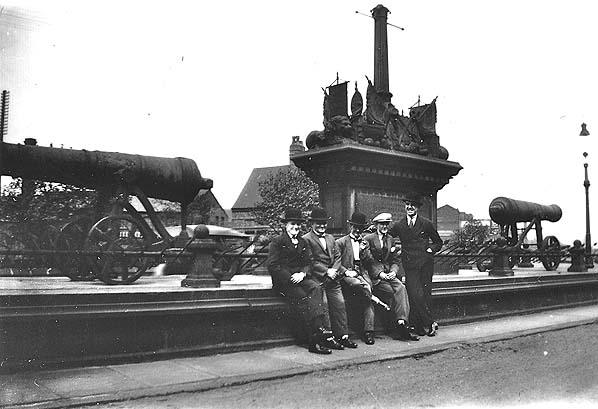
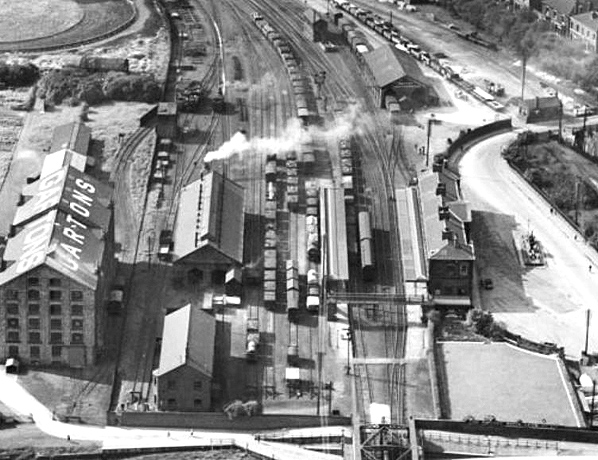
.jpg) Looking east at Warrington
Arpley station in April 1957.
Looking east at Warrington
Arpley station in April 1957.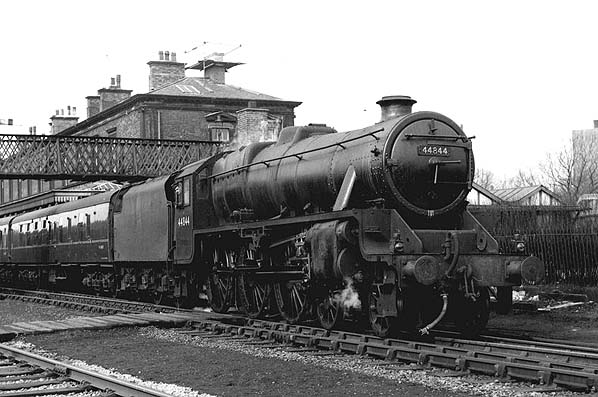
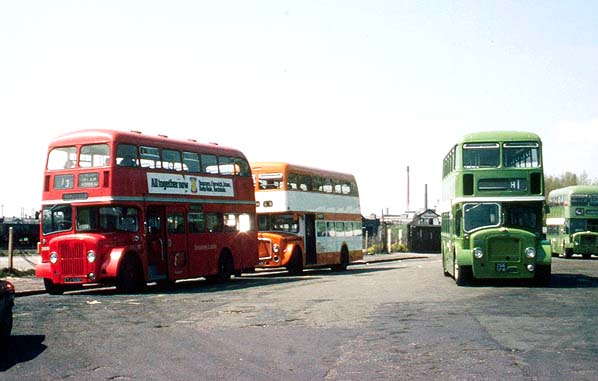
 Home Page
Home Page 
 The centrepiece of the two-storey, E-plan building was a large pediment with three windows beneath; on the ground floor the rectangular openings had dripstones above, and on the upper floor a Venetian window was flanked by rectangular openings, each with a pediment. The absence of the doorway and portico that might be expected in the centrepiece detracted somewhat from the visual satisfaction of the building. In the wings at either end of the building the single upper storey window was surmounted by a pediment, with a triple-arched window on the ground floor. Between the centrepiece and each of the two wings was a range of windows, with pediments on the upper floor and dripstones on the ground floor. String courses added interest between the ground and upper floors. The chimneystacks were of modest size. Originally a sloping glazed awning was clasped between the centrepiece and each of the wings. Less ornamentation was provided on the straight platform elevation where a range of twelve windows with dripstones overlooked the trainshed, or later, the canopy. On the south platform there appear to have been no facilities; a screen wall supported the trainshed.
The centrepiece of the two-storey, E-plan building was a large pediment with three windows beneath; on the ground floor the rectangular openings had dripstones above, and on the upper floor a Venetian window was flanked by rectangular openings, each with a pediment. The absence of the doorway and portico that might be expected in the centrepiece detracted somewhat from the visual satisfaction of the building. In the wings at either end of the building the single upper storey window was surmounted by a pediment, with a triple-arched window on the ground floor. Between the centrepiece and each of the two wings was a range of windows, with pediments on the upper floor and dripstones on the ground floor. String courses added interest between the ground and upper floors. The chimneystacks were of modest size. Originally a sloping glazed awning was clasped between the centrepiece and each of the wings. Less ornamentation was provided on the straight platform elevation where a range of twelve windows with dripstones overlooked the trainshed, or later, the canopy. On the south platform there appear to have been no facilities; a screen wall supported the trainshed.  Things went from bad to worse for the W&S. Companies such as the BJR had obtained running rights over the line and the W&S had anticipated healthy receipts from them. The Great Western Railway (GWR) was a partner in the BJR and it intended to run services to Manchester via the W&S. In spring 1855 the line from Warrington Arpley to Walton Junction opened (the junction being just to the west of the station) making the GWR plan feasible. The problem was that the GWR and the LNWR were hostile to each other and the LNWR would not allow the GWR to use the MSJAR. The W&S had obtained an Act to build a line to Stockport at the time of its name change, but because of the turn of events it did not have the funds to proceed and the powers lapsed. The W&S company was never to reach Stockport.
Things went from bad to worse for the W&S. Companies such as the BJR had obtained running rights over the line and the W&S had anticipated healthy receipts from them. The Great Western Railway (GWR) was a partner in the BJR and it intended to run services to Manchester via the W&S. In spring 1855 the line from Warrington Arpley to Walton Junction opened (the junction being just to the west of the station) making the GWR plan feasible. The problem was that the GWR and the LNWR were hostile to each other and the LNWR would not allow the GWR to use the MSJAR. The W&S had obtained an Act to build a line to Stockport at the time of its name change, but because of the turn of events it did not have the funds to proceed and the powers lapsed. The W&S company was never to reach Stockport.  For a brief period during the railway war the W&S line had taken on a role of importance just as its promotors had anticipated. During 1858 the SHC&RC and the MS&LR considered leasing the W&S but in autumn1858 the railway war ended. It had cost all of the companies a great deal of money as they had cut fares and put on services in competition to each other. The ending of the railway war saw the withdrawal of the GNR London Kings Cross service. In November 1858 Warrington Arpley lost the MS&LR services between Manchester and Garston/Chester.
For a brief period during the railway war the W&S line had taken on a role of importance just as its promotors had anticipated. During 1858 the SHC&RC and the MS&LR considered leasing the W&S but in autumn1858 the railway war ended. It had cost all of the companies a great deal of money as they had cut fares and put on services in competition to each other. The ending of the railway war saw the withdrawal of the GNR London Kings Cross service. In November 1858 Warrington Arpley lost the MS&LR services between Manchester and Garston/Chester.  Once again the rivalry between companies had an impact on Warrington Arpley. The LNWR did all that it could to inconvenience the CLC trains. This resulted in the CLC building its own line between Garston and Manchester, with a branch to Stockport. The line opened in two stages on 1 August and 2 September 1873 and Warrington Arpley lost its CLC services.
Once again the rivalry between companies had an impact on Warrington Arpley. The LNWR did all that it could to inconvenience the CLC trains. This resulted in the CLC building its own line between Garston and Manchester, with a branch to Stockport. The line opened in two stages on 1 August and 2 September 1873 and Warrington Arpley lost its CLC services. 